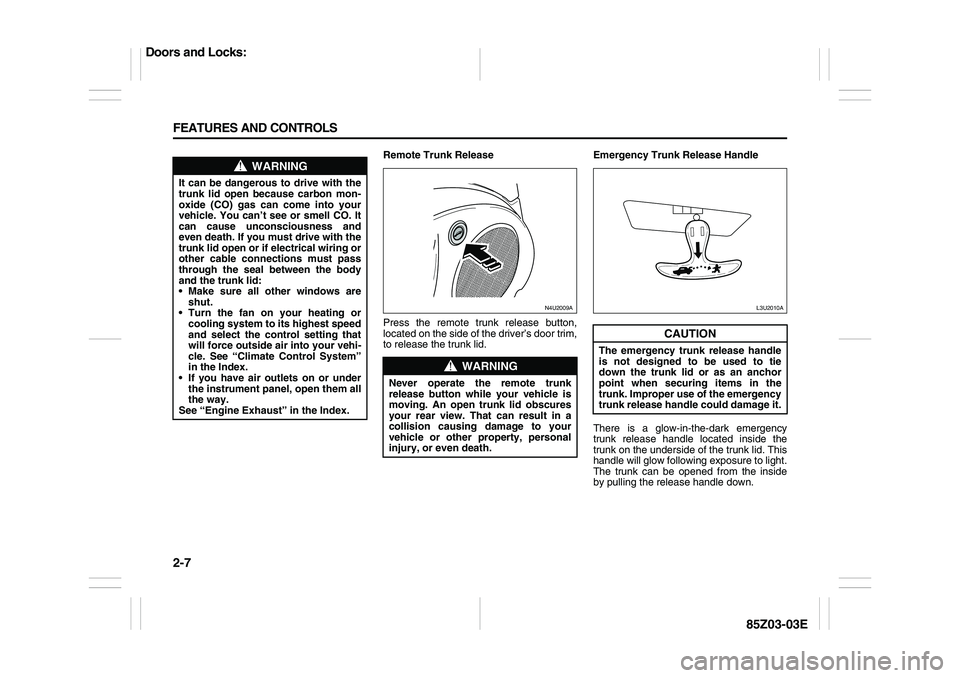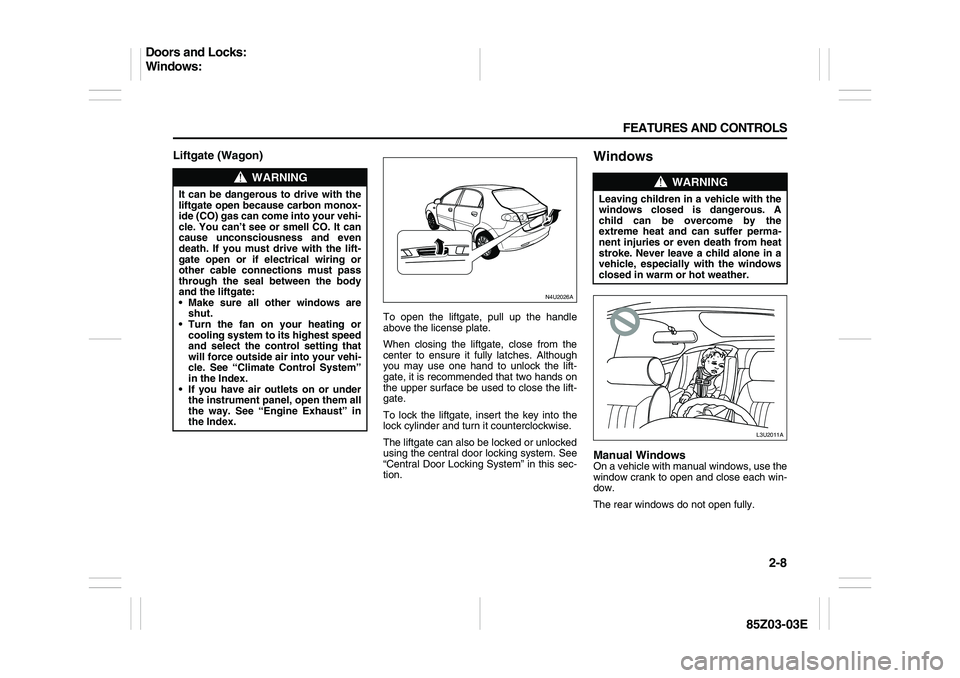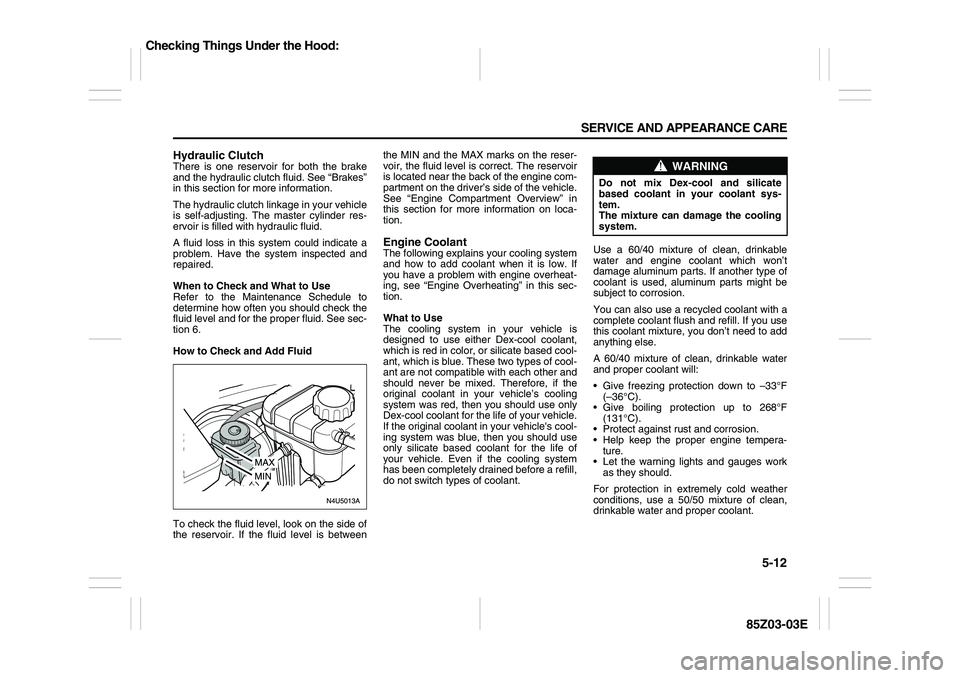2007 SUZUKI FORENZA heating
[x] Cancel search: heatingPage 55 of 225

2-7 FEATURES AND CONTROLS
85Z03-03E
Remote Trunk Release
Press the remote trunk release button,
located on the side of the driver’s door trim,
to release the trunk lid.Emergency Trunk Release Handle
There is a glow-in-the-dark emergency
trunk release handle located inside the
trunk on the underside of the trunk lid. This
handle will glow following exposure to light.
The trunk can be opened from the inside
by pulling the release handle down.
WARNING
It can be dangerous to drive with the
trunk lid open because carbon mon-
oxide (CO) gas can come into your
vehicle. You can’t see or smell CO. It
can cause unconsciousness and
even death. If you must drive with the
trunk lid open or if electrical wiring or
other cable connections must pass
through the seal between the body
and the trunk lid:
Make sure all other windows are
shut.
Turn the fan on your heating or
cooling system to its highest speed
and select the control setting that
will force outside air into your vehi-
cle. See “Climate Control System”
in the Index.
If you have air outlets on or under
the instrument panel, open them all
the way.
See “Engine Exhaust” in the Index.
WARNING
Never operate the remote trunk
release button while your vehicle is
moving. An open trunk lid obscures
your rear view. That can result in a
collision causing damage to your
vehicle or other property, personal
injury, or even death.
N4U2009A
CAUTION
The emergency trunk release handle
is not designed to be used to tie
down the trunk lid or as an anchor
point when securing items in the
trunk. Improper use of the emergency
trunk release handle could damage it.
L3U2010A
Doors and Locks:
Page 56 of 225

2-8 FEATURES AND CONTROLS
85Z03-03E
Liftgate (Wagon)
To open the liftgate, pull up the handle
above the license plate.
When closing the liftgate, close from the
center to ensure it fully latches. Although
you may use one hand to unlock the lift-
gate, it is recommended that two hands on
the upper surface be used to close the lift-
gate.
To lock the liftgate, insert the key into the
lock cylinder and turn it counterclockwise.
The liftgate can also be locked or unlocked
using the central door locking system. See
“Central Door Locking System” in this sec-
tion.
WindowsManual WindowsOn a vehicle with manual windows, use the
window crank to open and close each win-
dow.
The rear windows do not open fully.
WARNING
It can be dangerous to drive with the
liftgate open because carbon monox-
ide (CO) gas can come into your vehi-
cle. You can’t see or smell CO. It can
cause unconsciousness and even
death. If you must drive with the lift-
gate open or if electrical wiring or
other cable connections must pass
through the seal between the body
and the liftgate:
Make sure all other windows are
shut.
Turn the fan on your heating or
cooling system to its highest speed
and select the control setting that
will force outside air into your vehi-
cle. See “Climate Control System”
in the Index.
If you have air outlets on or under
the instrument panel, open them all
the way. See “Engine Exhaust” in
the Index.
N4U2026A
WARNING
Leaving children in a vehicle with the
windows closed is dangerous. A
child can be overcome by the
extreme heat and can suffer perma-
nent injuries or even death from heat
stroke. Never leave a child alone in a
vehicle, especially with the windows
closed in warm or hot weather.
L3U2011A
Doors and Locks:
Windows:
Page 74 of 225

2-26 FEATURES AND CONTROLS
85Z03-03E
windshield glass to avoid causing breaks in
the resistive material heating element
which can adversely affect radio and
defogger performance. See your SUZUKI
dealer for details.
SunroofIf your vehicle has this feature, the switch
is located between the map lamp buttons.
The sunroof will only operate when the
ignition is in the ON position. The sunroof
can be opened to a vent position or it can
be opened all the way.
You must manually open and close the
sunroof cover.
To open the sunroof to the vent position,
push the front part of the switch. To return
the sunroof to its original position, push the
rear part of the switch and hold it until the
sunroof reaches the desired position.
To fully open the sunroof, push the rear
part of the switch. The sunroof will open
automatically until you push either the front
or the rear part of the switch again. To
close the sunroof, push the front part of theswitch and hold it until the sunroof is
closed. The sunroof will stop if the switch is
released during operation.
In both the vent and fully open positions,
the air flow can be adjusted for driving
comfort by pushing and holding the switch
until the sunroof moves to the desired posi-
tion.
The sunroof glass panel cannot be opened
or closed if your vehicle has an electrical
failure.
N4U2024A
WARNING
Never allow any part of your body
such as hands or head to stick out
of the sunroof opening while the
vehicle is moving.
Be sure there are no hands or other
obstructions in the path of the sun-
roof when you close the sunroof.
Always remove the ignition key
when leaving the vehicle even if for
a short time. Also do not leave chil-
dren alone in a parked vehicle.
Unattended children could use the
sunroof switches and get trapped
by the sunroof.
Do not put your body weight on the
roof around the sunroof such as by
sitting on it.
When leaving the vehicle unat-
tended, close the sunroof fully.
Sunroof:
Page 88 of 225

3-12 INSTRUMENT PANEL
85Z03-03E
The cigarette lighter is located to the right
of the front ashtray.
To use it, turn the ignition to ACC or ON,
push the cigarette lighter in all the way and
let go. When it’s ready, it will pop back out
by itself.
ClockThe time is displayed in the digital clock
when the ignition is on. The clock is
located in the center of the instrument
panel. There are three adjusting buttons
for the digital clock:
H (Hour):
To go forward one hour, press the “H” but-
ton once, with the ignition on. To go for-
ward more than one hour, press and hold
the button until the correct hour is reached.M (Minute):
To go forward one minute, press the “M”
button once, with the ignition on. To go for-
ward more than one minute, press and
hold the button until the correct minute is
reached.
S (Set):
To reset the time to the nearest hour, press
the “S” button.
For example, if this button is pressed while
the time is between 8:00 and 8:29, the dis-
play is set to 8:00. If this button is pressed
while the time is between 8:30 and 8:59,
the display is set to 9:00.
After disconnecting the battery or after
replacing the fuse, reset the clock.
WARNING
Don’t put papers or other flammable
items into your ashtrays. Hot ciga-
rettes or other smoking materials
could ignite them, causing a damag-
ing fire.
CAUTION
Don’t hold a cigarette lighter in with
your hand while it is heating. If you
do, it won’t be able to back away from
the heating element when it’s ready.
That can make it overheat, damaging
the lighter and the heating element.
Instrument Panel Overview:
Climate Controls:
Page 90 of 225

3-14 INSTRUMENT PANEL
85Z03-03E
(Bi-Level):
This mode directs approximately half of the
air to the instrument panel outlets, and
then directs the remaining air to the floor
outlets. (Floor):
This mode directs most of the air to the
floor outlets. Some of the air will also be
directed to the windshield, instrument
panel side outlets, and rear outlets. Be
sure to keep the area under the front seats
clear to allow the flow of air to the rear
compartment.Recirculation
Press this button when driving in dusty
conditions or to avoid traffic or outside
fumes, and when quick cooling or heating
of the passenger area is required. The
indicator light will illuminate and interior air
will be reclaculated.
Pressing the recirculation mode button
again will draw outside air into the passen-
ger compartment. The indicator will go out.
Your windows may fog if you use the recir-
culation mode for extended periods. If this
happens, select the defrost mode.
N4U3027AN4U3027A
N4U3028AN4U3028A
Climate Controls:
Page 98 of 225

3-22 INSTRUMENT PANEL
85Z03-03E
Speed Sensitive Power Steering
(SSPS) Warning LightIf your vehicle has Speed Sensitive Power
Steering (SSPS), this warning light will
come on briefly when you turn the ignition
to ON as a check to show you the bulb is
working.
Then it should go out after a few seconds.
If the warning light does not come on, have
it fixed so it will be able to warn you if there
is a problem.
If the warning light stays on, or comes on
while you are driving, the SSPS system
may not be working. If this happens, see
your SUZUKI dealer for service.
Hold Mode LightIf your vehicle has this feature, this light will
come on when the Hold mode is active.
If the HOLD mode light flashes, have your
vehicle checked.
See “Hold Mode” under “Automatic Trans-
mission Operation” in section 2 for addi-
tional information on this feature.Engine Coolant Temperature GaugeYour vehicle is equipped with an engine
coolant temperature gauge. With the igni-tion in the ON position, this gauge shows
the engine coolant temperature.
If the gauge pointer moves into the red
area, your engine is too hot! It means that
your engine coolant has overheated.
If you have been operating your vehicle
under normal driving conditions, you
should pull off the road, stop your vehicle
and turn off the engine as soon as possi-
ble.
See “Engine Overheating” in section 5.
Malfunction Indicator LampCheck Engine Light
Your vehicle is equipped with a computer
which monitors operation of the fuel, igni-
tion and emission control systems.
This system is called OBD II (On-Board
Diagnostics-Second Generation) and is
intended to assure that emissions are at
acceptable levels for the life of the vehicle,
helping to produce a cleaner environment.
The Check Engine Light comes on to indi-
cate that there is a problem and service is
required. Malfunctions often will be indi-
N5U3003A
S5U3008AS
Warning Lights, Gauges and Indicators:
Page 156 of 225

5-12 SERVICE AND APPEARANCE CARE
85Z03-03E
Hydraulic ClutchThere is one reservoir for both the brake
and the hydraulic clutch fluid. See “Brakes”
in this section for more information.
The hydraulic clutch linkage in your vehicle
is self-adjusting. The master cylinder res-
ervoir is filled with hydraulic fluid.
A fluid loss in this system could indicate a
problem. Have the system inspected and
repaired.
When to Check and What to Use
Refer to the Maintenance Schedule to
determine how often you should check the
fluid level and for the proper fluid. See sec-
tion 6.
How to Check and Add Fluid
To check the fluid level, look on the side of
the reservoir. If the fluid level is betweenthe MIN and the MAX marks on the reser-
voir, the fluid level is correct. The reservoir
is located near the back of the engine com-
partment on the driver’s side of the vehicle.
See “Engine Compartment Overview” in
this section for more information on loca-
tion.
Engine CoolantThe following explains your cooling system
and how to add coolant when it is low. If
you have a problem with engine overheat-
ing, see “Engine Overheating” in this sec-
tion.
What to Use
The cooling system in your vehicle is
designed to use either Dex-cool coolant,
which is red in color, or silicate based cool-
ant, which is blue. These two types of cool-
ant are not compatible with each other and
should never be mixed. Therefore, if the
original coolant in your vehicle’s cooling
system was red, then you should use only
Dex-cool coolant for the life of your vehicle.
If the original coolant in your vehicle's cool-
ing system was blue, then you should use
only silicate based coolant for the life of
your vehicle. Even if the cooling system
has been completely drained before a refill,
do not switch types of coolant.Use a 60/40 mixture of clean, drinkable
water and engine coolant which won’t
damage aluminum parts. If another type of
coolant is used, aluminum parts might be
subject to corrosion.
You can also use a recycled coolant with a
complete coolant flush and refill. If you use
this coolant mixture, you don’t need to add
anything else.
A 60/40 mixture of clean, drinkable water
and proper coolant will:
Give freezing protection down to –33°F
(–36°C).
Give boiling protection up to 268°F
(131°C).
Protect against rust and corrosion.
Help keep the proper engine tempera-
ture.
Let the warning lights and gauges work
as they should.
For protection in extremely cold weather
conditions, use a 50/50 mixture of clean,
drinkable water and proper coolant.
WARNING
Do not mix Dex-cool and silicate
based coolant in your coolant sys-
tem.
The mixture can damage the cooling
system.
Checking Things Under the Hood:
Page 158 of 225

5-14 SERVICE AND APPEARANCE CARE
85Z03-03E
When replacing the pressure cap, make
sure it is hand-tight.Coolant Surge Tank Pressure Cap
Engine OverheatingYou will find a coolant temperature gauge
on your vehicle’s instrument panel. See
“Engine Coolant Temperature Gauge” in
section 3.If Steam Is Coming From Your Engine
If No Steam Is Coming From Your
Engine
If you get an engine overheat warning, but
see or hear no steam, the problem may not
be too serious. Sometimes the engine can
get a little too hot when you:
Climb a long hill on a hot day.
Stop after high-speed driving.
Idle for long periods in traffic.
If you get the overheat warning with no
sign of steam, try this for a minute or so:
1) In heavy traffic, let the engine idle in
NEUTRAL while stopped. If it is safe to
do so, pull off the road, shift to PARK
(P) or NEUTRAL and let the engine
idle.
2) Turn on your heater to full hot at the
highest fan speed and open the window
as necessary.
If you no longer have the overheat warn-
ing, you can drive. Just to be safe, drive
slower for about 10 minutes. If the warning
doesn’t come back on, you can drive nor-
mally.
CAUTION
Your coolant surge tank cap is a
pressure-type cap and must be
tightly installed to prevent coolant
loss and possible engine damage
from overheating. See “Capacities
and Specifications” for more informa-
tion.
WARNING
Steam from an overheated engine
can burn you badly, even if you just
open the hood. Stay away from the
engine if you see or hear steam com-
ing from it. Just turn it off and get
everyone away from the vehicle until
it cools down. Wait until there is no
sign of steam or coolant before you
open the hood.
If you keep driving when your engine
is overheated, the liquids in it can
catch fire. You or others could be
badly burned. Stop your engine if it
overheats, and get out of the vehicle
until the engine is cool.
CAUTION
If your engine catches fire because
you keep driving with no coolant,
your vehicle can be badly damaged.
The costly repairs would not be cov-
ered by your warranty.
Checking Things Under the Hood: